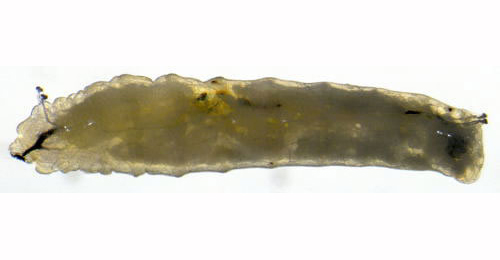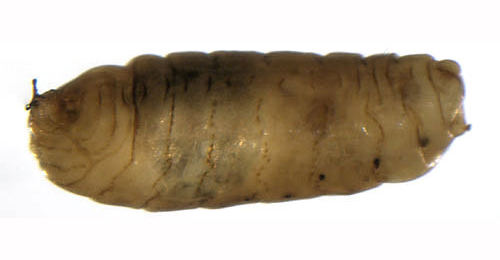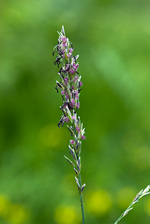|
||||||
|
MOLINIA. Purple Moor-grass. [Poaceae] |
|
|
Only one species of Molinia is recorded in Britain - Purple Moor-grass (M. caerulea). It is a native species. The BSBI provide a downloadable plant crib for Molinia caerulea subsp. caerulea and subsp. arundinacea. Seven British miners are recorded on Molinia. Nearly 100 British miners or possible miners are recorded on grasses in Britain. A key to the European miners recorded on Molinia is provided in Bladmineerders van Europa. It is recommended that adults of all miners on grasses be reared to be certain of their identity. |
|
Key for the identification of the known mines of British |
Note: Diptera larvae may live in a corridor mine, a corridor-blotch mine, or a blotch mine, but never in a case, a rolled or folded leaf, a tentiform mine or sandwiched between two more or less circular leaf sections in later instars. Pupation never in a cocoon. All mining Diptera larvae are leg-less maggots without a head capsule (see examples). They never have thoracic or abdominal legs. They do not have chewing mouthparts, although they do have a characteristic cephalo-pharyngeal skeleton (see examples), usually visible internally through the body wall. The larvae lie on their sides within the mine and use their pick-like mouthparts to feed on plant tissue. In some corridor miners frass may lie in two rows on alternate sides of the mine. In order to vacate the mine the fully grown larva cuts an exit slit, which is usually semi-circular (see Liriomyza huidobrensis video). The pupa is formed within the hardened last larval skin or puparium and as a result sheaths enclosing head appendages, wings and legs are not visible externally (see examples). See Key to non-Diptera. |
1a > Leaf-miner: Pupation internal. |
1b > Leaf-miner: Pupation external. |
2a > Leaf-miner: Long, narrow, whitish mine. Pupation internal (Spencer, 1976: 453); anterior spiracles projecting through the epidermis. Whitish, upper-surface, rather narrow corridor with comparatively large frass grains that are laying further apart than their diameter. Pupation within the mine. The anterior spiracles of the orange-brown puparium penetrate the epidermis. |
 Chromatomyia nigra larva, lateral Image: © Willem Ellis (Bladmineerders van Europa) |
 Chromatomyia nigra pupa, lateral Image: © Willem Ellis (Bladmineerders van Europa) |
|
Chromatomyia nigra (Meigen, 1830) [Diptera: Agromyzidae]. |
2b > Leaf-miner: Narrow whitish mine, with frass in distinct black lumps. Pupation internal |
|
Chromatomyia fuscula (Zetterstedt, 1838) [Diptera: Agromyzidae]. |
2c > Leaf-miner: Broad elongated mine; the form is dependent of the leaf form of the host plant. Frass green. Usually a number of larvae together in a mine. Pupation in the mine. |
|
Cerodontha incisa (Meigen, 1830) [Diptera: Agromyzidae]. |
3b > Leaf-miner: More than one larva in mine. |
4a > Leaf-miner: Larvae feed singly, forming an upper surface linear-blotch mine. Pupation either internal or external. Puparium reddish, brown or black, frequently adhering to leaf near end of mine. |
 Mine of Agromyza albipennis on Phalaris arundinacea Image: © Willem Ellis (Bladmineerders van Europa) |
|
Agromyza albipennis Meigen, 1830 [Diptera: Agromyzidae]. |
4b > Leaf-miner: Larvae feed singly, forming greenish mine, initially running towards apex of leaf before turning back down and developing into a broad blotch. Puparium reddish brown. |
|
Agromyza rondensis Strobl, 1900 [Diptera: Agromyzidae]. |
5a > Leaf-miner: Normally several larvae feed together. Pupation in the mine. Puparium shining black (Spencer, 1976: 198). Broad elongated blotch. Frass greenish. Larvae generally communal. Pupation within the mine. The black puaria are individially anchored within the mine with a silken thread attached at their rear end. Distinguishable from C. incisa only by means of the larva. |
|
Cerodontha pygmaea (Meigen, 1830) [Diptera: Agromyzidae]. |
5b > Leaf-miner: Upper-surface, unusually short corridor (ca. 4 cm). Puparium brown |
|
Liriomyza pusio (Meigen, 1830) [Diptera: Agromyzidae]. |
|
Key for the identification of the known mines of British |
Note: The larvae of mining Coleoptera, Hymenoptera and Lepidoptera may live in a corridor mine, a corridor-blotch mine, a blotch mine, a case, a rolled or folded leaf, a tentiform mine or sandwiched between two more or less circular leaf sections in later instars. Larva may pupate in a silk cocoon. The larva may have six legs (although they may be reduced or absent), a head capsule and chewing mouthparts with opposable mandibles (see video of a gracillarid larva feeding). Larvae of Hymenoptera and Lepidoptera usually also have abdominal legs (see examples). Frass, if present, never in two rows. Unless feeding externally from within a case the larva usually vacates the mine by chewing an exit hole. Pupa with visible head appendages, wings and legs which lie in sheaths (see examples). |
1 > Leaf-miner: The larva creates a long narrow mine in the blade. Mine fairly translucent. It starts as a narrow corridor, running towards the leaf tip, but this almost invariably is overrun be a later, broad, descending corridor. The centre of the mine contains a vertical tube made of loose silk, in which the larva can quickly move up or down, and in which also most frass gets trapped. The sides of the mine are smooth (contrary to E. gangabella). Mines are difficult to find, because the leaves are wilting when larvae are present. |
|
Elachista subalbidella Schläger, 1847 [Lepidoptera: Elachistidae]. |
| Last updated 06-Jul-2019 Brian Pitkin | ||

